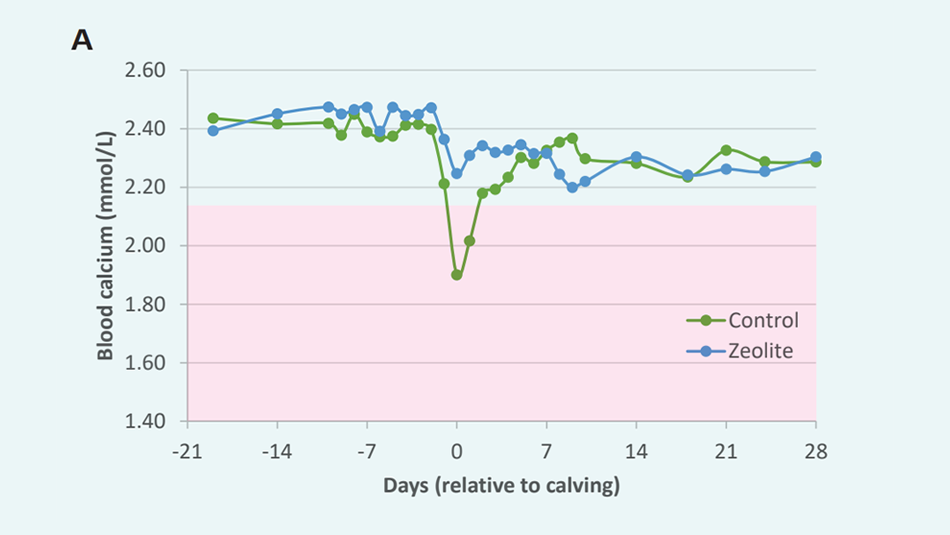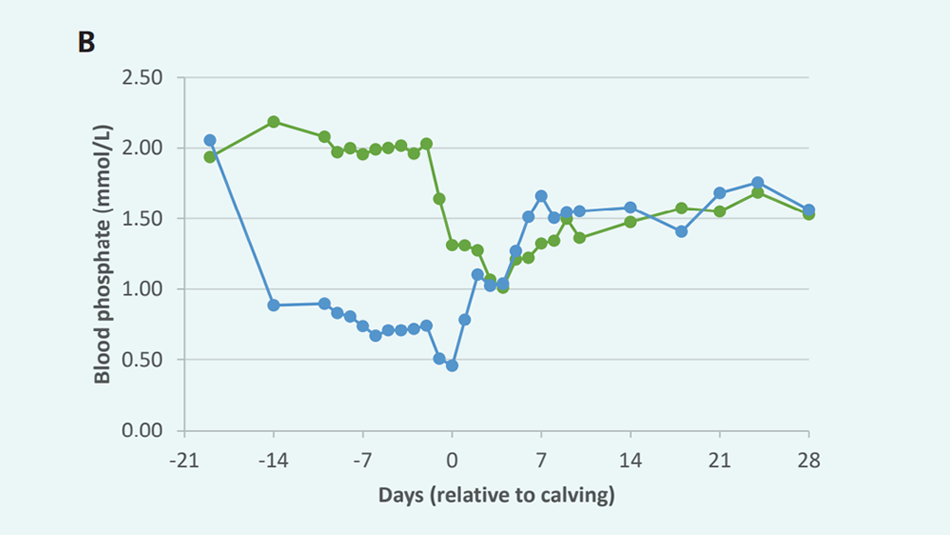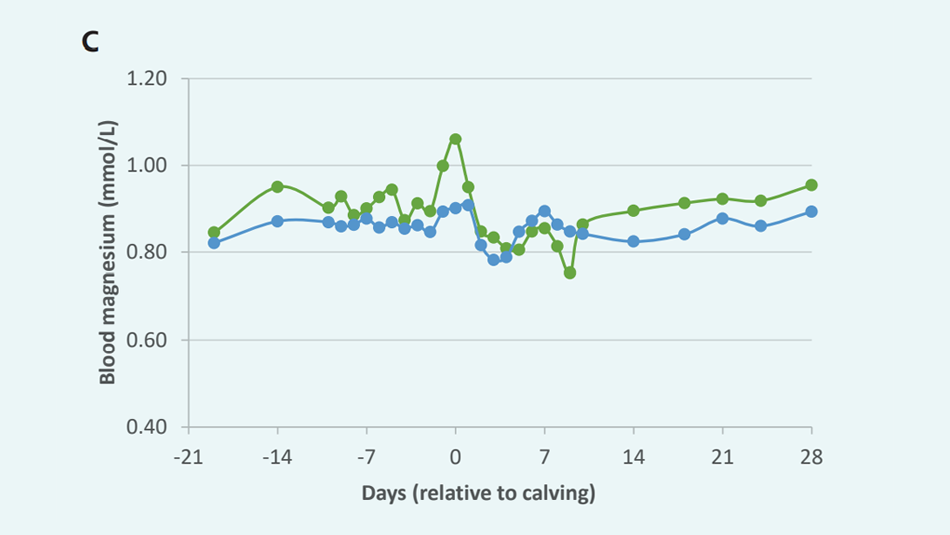Synthetic Zeolite Pre Calving
8 min read
Milk fever is a metabolic disorder in cows caused by a sudden high demand for calcium during the start of lactation. DairyNZ experiments show that feeding cows synthetic zeolite for two to three weeks before calving can reduce the risk of milk fever in pasture-based systems. Synthetic zeolite binds to dietary calcium and other minerals in the cow's rumen, promoting increased calcium absorption from the intestines. This helps to maintain stable blood calcium levels in cows. Still, it's essential to manage magnesium supplementation correctly when using zeolite. While synthetic zeolite can reduce milk fever, it might not improve herd reproductive performance.
A series of DairyNZ-led experiments have confirmed that supplementing cows with synthetic zeolite for two to three weeks pre-calving reduces the risk of milk fever in pasture-based systems.
Milk fever is a common metabolic disorder affecting cows around calving when they experience a sudden massive demand for calcium at the onset of lactation. Cows tightly regulate their blood calcium concentrations, but if they're unable to keep up with the demand for calcium, blood concentrations decrease. This is known as 'hypocalcaemia’.
Milk fever is defined as subclinical when the cow is hypocalcaemic with blood calcium concentrations less than 2.15mmol/L but is not exhibiting signs of disease. Approximately 35-50% of cows in a herd succumb to subclinical milk fever at calving, whereas about 2-5% exhibit clinical milk fever with evident changes in behaviour and rumination1,2. In many cases, these cows become recumbent – commonly known as 'downer' cows.
Both subclinical and clinical milk fever are associated with an increased risk of other metabolic disorders (e.g., ketosis), infectious diseases (e.g., mastitis, uterine disease), and removal from the herd. For this reason, milk fever is known as a ‘gateway disease’ and considerable research efforts have been undertaken to prevent this disorder and mitigate its effects.
In New Zealand pasture-based systems, supplementing cows with magnesium from two to three weeks pre-calving until mid-lactation is a common strategy to prevent milk fever. That’s because magnesium plays a crucial role in maintaining blood calcium concentrations.
Other mitigation strategies (Table 1) include ensuring body condition score (BCS) targets at calving are met, and supplementing cows with limeflour, a calcium source, during the colostrum period. Despite these strategies, subclinical milk fever remains highly prevalent, and clinical milk fever is still a major issue on many farms.
Synthetic zeolite is a sodium aluminosilicate supplement. It is commonly fed pre-calving in European indoor systems to reduce the risk of cows developing clinical and subclinical milk fever after calving. This strategy is well supported by peer-reviewed research in these systems3 and, more recently, has been validated to reduce hypocalcaemia in high-yielding cows managed in a North American housed system4.
By feeding synthetic zeolite for two to three weeks before calving, dietary calcium and other minerals are bound in the cow’s rumen and pass through into the faeces. This stimulates her to increase calcium absorption from the intestines and prepares her to cope with increased calcium demands after calving. As a result, her blood calcium concentrations are maintained.
As research data in grazing systems was lacking, DairyNZ conducted a series of experiments investigating synthetic zeolite under New Zealand conditions. We confirmed that zeolite reduces the risk of subclinical and clinical milk fever in grazing cows supplemented with maize silage pre-calving.
In trials conducted at DairyNZ’s Lye Farm, Waikato, we determined that feeding cows 500g/day of synthetic zeolite for two to three weeks before their expected calving date increased blood calcium concentrations at calving5 (Figure 1a).
Zeolite also resulted in a large pre-calving reduction in blood phosphate concentrations that persisted until about three days post-calving5 (Figure 1b). This effect was expected, based on results from overseas trials, and is part of zeolite’s mechanism of action to prevent milk fever. However, the effects and safety of synthetic zeolite in diets already deficient in phosphorus are presently unknown. Therefore, synthetic zeolite is not currently recommended when diets include high amounts of fodder beet.
Cows fed synthetic zeolite had lower blood magnesium concentrations but were not at risk of becoming hypomagnesaemic5 (Figure 1c). Both control cows and zeolite-treated cows were supplemented with magnesium as per best farm practice. Careful management of magnesium supplementation pre- and post-calving is still required when using zeolite, especially in herds with a borderline magnesium status, to minimise the risk of grass staggers.
Interestingly, the DairyNZ experiments also indicated that synthetic zeolite may improve uterine health and herd reproductive performance, as zeolite-treated cows tended to conceive earlier in the breeding season. This later result was consistent with a recent trial in housed cows fed a total mixed ration at Cornell University, USA4 . However, both DairyNZ and overseas experiments were conducted with a small number of animals under highly controlled conditions and required validation with larger numbers of cows across commercial herd environments.

Figure 1A
Figure 1B
Figure 1C
Figure 1: The effect of feeding synthetic zeolite for two to three weeks pre-calving on blood concentrations of (A) calcium, (B) phosphate and (C) magnesium, relative to untreated controls. Pink shaded area shows threshold for hypocalcaemia.
Therefore, a two-year study was conducted to:
During the 2019/20 season, approximately 1000 cows across three herds in the Waikato were enrolled in the Zeolite Scale-Up Trial, with another 1500 cows across three herds participating the next season. During each season, half of the cows in each herd received 500g/day of synthetic zeolite for three weeks pre-calving.
Results clearly demonstrated that feeding synthetic zeolite pre-calving consistently reduced the incidence of clinical milk fever cases: from an average of 4.4% in untreated control cows to 1.2% in zeolite-treated cows. This meant zeolite-treated cows were nearly four times less likely to succumb to clinical milk fever.

Figure 2: Feeding synthetic zeolite for three weeks pre-calving improved blood calcium concentrations within one day of calving, especially in herds with hypocalcaemia issues in untreated controls.
It also reduced the incidence of subclinical milk fever, as cows fed zeolite had higher blood calcium concentrations within one day of calving (Figure 2). As expected, blood magnesium and phosphate concentrations at this time were lower in zeolite-treated cows.
There were some differences between herds in their blood mineral responses to zeolite (Figure 2), indicating that herds with a history of milk fever issues are likely to benefit the most from this strategy. Results also indicated that synthetic zeolite is most effective in reducing milk fever when delivered to springer cows using maize silage or meal in troughs/bins or using pelletised feed via in-shed systems. Poorer responses will be obtained if synthetic zeolite is topdressed onto pasture silage in the paddock, as large amounts are wasted and not ingested by cows.
We did not detect any improvements in submission, conception or in-calf rates in zeolite-treated cows. This suggests the strategy will not lead to better herd reproductive performance.

Table 2: The effect of feeding synthetic zeolite for three weeks pre-calving on milk production (at ~6 weeks in milk), relative to untreated controls.
Similarly, we did not determine any difference in uterine health, measured by Metricheck scoring at one month after calving. We also saw no differences in cases of clinical mastitis between calving and mating start date. However, the incidence of cows with somatic cell counts greater than 200,000 cells/ml at the first herd test (about six weeks in milk) was lower in the zeolite-treated cows than in untreated controls: 10% vs 14%. Hence, there may be some benefits to mammary health and milk quality.
Feeding zeolite pre-calving resulted in small (less than 2%) but statistically significant reductions in milk volume and milksolids yields, measured at the first herd test after calving (Table 2). These effects may be related to suppressed dry matter intake pre-calving, as reported in some overseas studies. Nevertheless, evidence from both small- and largescale studies indicates these effects are relatively subtle and most likely outweighed by the benefits of reduced subclinical and clinical milk fever.

Trial cows eating maize silage supplemented with synthetic zeolite pre-calving.

Trial cows moving back to their paddock after eating their daily allocation of synthetic zeolite pre-calving.
Should I use magnesium supplements with synthetic zeolite?
It’s important to use an optimal magnesium supplementation strategy starting at the same time pre-calving. Preferably, more than one method of magnesium supplementation should be used.
How does feeding synthetic zeolite pre-calving compare with reducing DCAD (dietary cation:anion difference)?
A negative DCAD pre-calving has been demonstrated to prevent milk fever in housed cows, but this can be difficult to achieve in grazing cows due to the high potassium content of pasture. Using synthetic zeolite is an alternative to a negative DCAD strategy, which requires adding large amounts of anionic salts of chloride and sulphate to the diet and feeding low-potassium feeds, such as maize silage.
When do I stop feeding synthetic zeolite?
Zeolite supplementation should stop immediately after a cow calves, so that she can absorb dietary calcium.
Is synthetic zeolite compatible with low-phosphorus diets, such as fodder beet?
This hasn’t been tested yet, so it is not recommended to feed synthetic zeolite when cows are on fodder beet or other low-phosphorus diets.
Does natural zeolite, mined from clay deposits, have the same effect as synthetic zeolite?
Synthetic zeolite is produced from natural zeolites to have a standardised composition. However, different types of zeolite have different mineral-binding properties in the cow’s gut, which alters their effects on the animal. Only synthetic zeolite is scientifically proven to reduce the risk of subclinical and clinical milk fever under a range of farm systems. The safety and efficacy of feeding natural zeolites pre-calving to reduce milk fever are unknown and, therefore, this is not recommended.
What is the palatability of synthetic zeolite?
Both DairyNZ and overseas experiments indicate that targeting a dose of 500g/cow/d is optimal – offering higher dose rates can reduce palatability and may limit feed intake. Mixing synthetic zeolite into supplementary feeds such as maize silage, or incorporating into pelletised feed rather than top-dressing onto feeds, can improve palatability, if required.
This research was conducted under the Pillars of a New Dairy System research programme, funded by New Zealand dairy farmers through the DairyNZ levy, and by the Ministry for Business, Innovation and Employment. We thank the farmers and their staff whose herds were enrolled in our Zeolite Scale-Up Trial.
1 Roche, J. R. 2003. The incidence and control of hypocalcaemia in pasture-based systems. Acta Veterinaria Scandinavica Supplementum 97:141-144.
2 Roberts, K. I., and S. McDougall. 2019. Risk factors for subclinical hypocalcaemia, and associations between subclinical hypocalcaemia and reproductive performance, in pasture-based dairy herds in New Zealand. New Zealand Veterinary Journal 67:12-19. doi: 10.1080/00480169.2018.1527732.
3 Thilsing-Hansen, T., and R. J. Jørgensen. 2001. Hot topic: Prevention of parturient paresis and subclinical hypocalcemia in dairy cows by zeolite A administration in the dry period. Journal of Dairy Science 84:691-693. doi: 10.3168/jds.S0022-0302(01)74523-7.
4 Kerwin, A. L., C. M. Ryan, B. M. Leno, M. Jakobsen, P. Theilgaard, D. M. Barbano, and T. R. Overton. 2019. Effects of feeding synthetic zeolite A during the prepartum period on serum mineral concentration, oxidant status, and performance of multiparous Holstein cows. Journal of Dairy Science 102:5191-5207. doi:10.3168/jds.2019-16272.
5 Crookenden, M. A., C. V. C. Phyn, S. A. Turner, J. J. Loor, A. I. Smith, V. Lopreiato, C. R. Burke, A. Heiser, and J. R. Roche. 2020. Feeding synthetic zeolite to transition dairy cows alters neutrophil gene expression. Journal of Dairy Science 103:723-736. doi:10.3168/jds.2019-17097.
This article was originally published in:
Now’s the perfect time to check in, plan, and set up for a strong season. We’ve pulled together smart tips and tools to help you stay ahead all winter long.
Whether you prefer to read, listen, or download handy guides, we’ve got you covered with trusted tools to support your journey every step of the way.